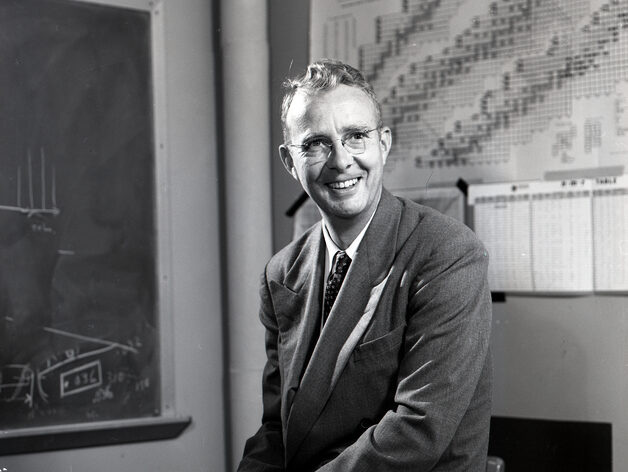Luis W. Alvarez was born in San Francisco, California, on June 13, 1911. He received his Bachelor of Science Degree from the University of Chicago in 1932, a Master of Science Degree in 1934, and his Ph.D. in 1936. Dr. Alvarez joined the Radiation Laboratory of the University of California, where he is now a professor, as a research fellow in 1936. He was on leave at the Radiation Laboratory of the Massachusetts Institute of Technology from 1940 to 1943, at the Los Alamos Laboratory of the Manhattan District from 1943 to 1945.
Professor Alvarez is a member of the following societies: National Academy of Sciences, American Philosophical Society, American Physical Society, and American Academy of Arts and Sciences. In 1946 he was awarded the Collier Trophy by the National Aeronautical Association for the development of Ground Control Approach, an aircraft landing system. In 1953 he was awarded the John Scott Medal and Prize by the city of Philadelphia, for the same work. In 1947 he was awarded the Medal for Merit. In 1960 he was named “California Scientist of the Year” for his research work on high energy physics. In 1961 he was awarded the Einstein Medal for his contribution to the physical sciences. In 1963, he was awarded the Pioneer Award of the AIEEE, in 1964 he was awarded the National Medal of Science for contributions to high energy physics, and in 1965 he received the Michelson Award. Sc. D., University of Chicago, 1967; Sc. D., Carnegie-Mellon University, 1968; Nobel Prize for Physics, 1968.
Seven LBL Nobel laureates, posed in front of Ernest Lawrence’s 37-inch cyclotron magnet. Left to right are Owen Chamberlain, Edwin McMillan, Emilio Serge, Melvin Calvin, Donald Glaser, Luis Alvarez and Glenn Seaborg. March 7, 1969.
Early in his scientific career, Dr. Alvarez worked concurrently in the fields of optics and cosmic rays. He is co-discoverer of the “East-West effect” in cosmic rays. In 1936, he joined the Radiation Laboratory at the University of California, and for several years concentrated his work in the field of nuclear physics. In 1937, he gave the first experimental demonstration of the existence of the phenomenon of K-electron capture by nuclei. Another early development was a method for producing beams of very slow neutrons. This method subsequently led to a fundamental investigation of neutron scattering in ortho- and parahydrogen, with Pitzer, and to the first measurement, with Bloch, of the magnetic moment of the neutron. With Wiens, he was responsible for the production of the first Hg198 lamp; this device was developed by the Bureau of Standards into its present form as the universal standard of length. Just before the war, Alvarez and Cornog discovered H3 (Tritium) and He3. (Tritium is best known as an ingredient of thermonuclear weapons, and He3 has become of importance in low temperature research.)
During the war (at M.I.T.) he was responsible for three important radar systems–the microwave early warning system, the Eagle high altitude bombing system, and a blind landing system of civilian as well as military value (GCA, mentioned earlier). While at the Los Alamos Laboratory, Professor Alvarez developed the detonators for setting off the plutonium bomb. He flew as a scientific observer at both the Alamagordo and Hiroshima explosions.
Dr. Alvarez is responsible for the design and construction of the Berkeley 40-foot proton linear accelerator, which was completed in 1947. Since that time, he has engaged in high energy physics, using the 6 billion electron volt Bevatron at the University of California Radiation Laboratory. His main efforts have been concentrated on the development and use of large liquid hydrogen bubble-chambers, and on the development of high speed devices to measure and analyze the millions of photographs produced each year by the bubble-chamber complex. The net result of this work has been the discovery by Dr. Alvarez’ research group, of a large number of previously unknown “fundamental particle resonances.”
© the Nobel Foundation 1969
